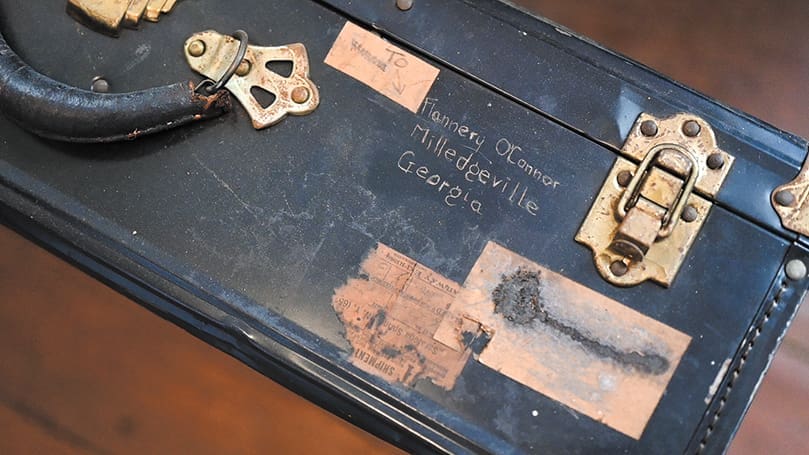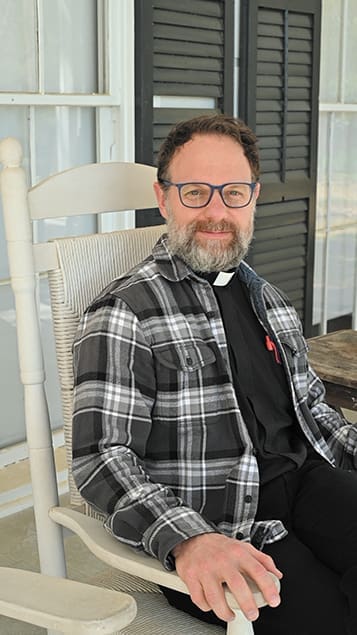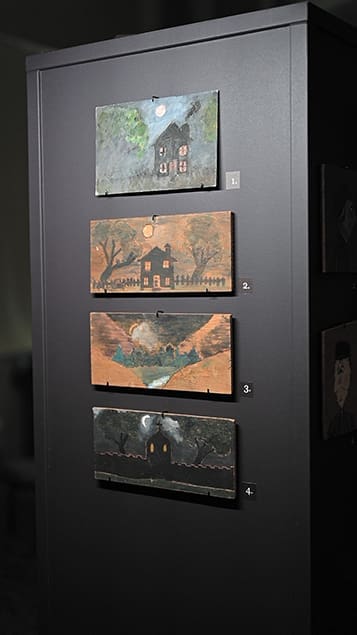 Photo by Julianna Leopold
Photo by Julianna LeopoldMilledgeville
Flannery O’Connor’s faith inspires new generation
By ANDREW NELSON, Staff Writer | Published April 4, 2025
MILLEDGEVILLE—Charlotte Aexel stood before the crowd of three dozen, narrating “A Good Man is Hard to Find” as fellow students brought Flannery O’Connor’s story to life.
Just blocks from their campus at Georgia College & State University, the young believers from Campus Catholics prayed in the red brick Sacred Heart Church where the acclaimed author’s faith was nourished.
David Belton portraying The Misfit, the leader of an escaped convict gang, delivered in an exaggerated Southern drawl one of the short story’s most iconic lines—“She would’ve been a good woman if it had been somebody there to shoot her every minute of her life.”

Father Bryan Kuhr, pastor of Sacred Heart Church in Milledgeville, and student Charlotte Aexel, stand in front of Flannery O’Connor’s photo in the church’s community hall. After reading “Wise Blood” in high school, Aexel was convinced to attend O’Connor’s alma mater and to recommit to the faith. Photo by Julianna Leopold
It was March 25, the Solemnity of Annunciation, also the 100th anniversary of O’Connor’s birth.
Through the shocking violence that leaves six people dead in the story, O’Connor finds a way to portray a moment of grace.
“There’s always a moment of grace and that definitely, for her and for readers, I think it’s the most important part of the story,” said Aexel.
The reader theater evening at the parish, following Mass, was just one of the celebrations surrounding O’Connor’s centennial in Milledgeville, about two hours south of Atlanta, along with a birthday cake of her beloved peacocks, book readings, the Andalusia Music Festival and displays of her newly-discovered art.
Born in Savannah in 1925, O’Connor earned national writing acclaim for her stories and novels. Scholars study her stories as they explore the intersection of faith and grace. After being diagnosed with lupus—the same illness that killed her father—she returned to her family’s Andalusia Farm here, where she spent her final 15 years. She died in 1964 at 39.
“Flannery O’Connor being born on this day, this solemnity, influenced her life. Now, according to Flannery, it was her Catholic faith, especially her belief in the Incarnation, that formed her imagination and worldview,” said Father Bryan Kuhr during his homily.
Young Catholics drawn to O’Connor
Sydney Logan is the president of Campus Catholics, a faith community of close to 60 students. The week of celebration gave her the chance to deepen her knowledge of O’Connor.

Students of Georgia College & State University perform a rendition of one of Flannery O’ Connor’s short stories for members of Campus Catholics. Sacred Heart Church hosted the reader theater event to celebrate O’Connor’s 100th birthday March 25. Photo by Julianna Leopold
Logan, 22, joined the church during her freshman year. She graduates in May with a degree in management information systems. At home in Alpharetta, she worships at St. Thomas Aquinas Church.
Logan admires O’Connor “seeing such passion and joy from someone that’s truly struggling and suffering” from lupus.
Aexel, another student, found her way to the faith through O’Connor’s fiction. She read “Wise Blood” her senior year in her Wisconsin high school. It moved her to get confirmed after being away from church for more than 10 years. She felt in her heart she would not be happy on any other college campus except in Milledgeville.
O’Connor didn’t try to be overly pious which makes her attractive to young people, said Aexel.
“She was just living her life and trying to be close to God. It was very genuine. And she wasn’t afraid to make jokes, write violent stories. She was still herself, and she knew that God loved her,” said Aexel.
‘Quasi-saint’ of Milledgeville
Being immersed in O’Connor—from worshipping at her church to interviewing the author’s contemporaries for an oral history campus project—fulfilled Aexel’s desire to know someone she views as a “quasi-saint,” not officially canonized but inspirational.

A pair of gloves, a cross and book that belonged to Flannery O’Connor sit on her desk at the family home in Milledgeville. Photo by Julianna Leopold
For the student, the author connects with people through her authenticity. She portrayed a faith that demanded honesty.
“She was very forthcoming with her prayer. A lot of people aren’t that way in prayer. They think maybe they can’t talk about some of the more difficult things, but (O’Connor) understood that it was already sort of inside her, and God was already seeing it,” said Aexel. “I think that’s really beautiful.”
As O’Connor was unapologetic about her faith, the Campus Catholics group builds up the student community, meeting twice a week, offering eucharistic adoration Thursday mornings and hosting regular faith talks. The Campus Catholic house holds a special connection to the author; her prayer kneeler is used by students in its chapel, a gift from the family estate.
Pilgrimage to Andalusia
Father Damian Ference is a scholar of O’Connor, in addition to working as the vicar for evangelization for the Diocese of Cleveland. He has brought students to Georgia on “pilgrimages” to better understand her.

Father Damian Ference, author of “Understanding the Hillbilly Thomist” about Flannery O’Connor, sits on the porch of the farmhouse at Andalusia, where she spent the last years of her life and wrote the bulk of her literary work. Photo by Julianna Leopold
“This would be my Disneyland or Disney World,” said the 49-year-old priest. It’s moving to be in the place that shaped her life and work, he said. He holds a doctorate in philosophy with a specialization on the philosophical foundations of O’Connor’s narrative art. His second book on O’Connor is scheduled to be published in the summer.
“She’s funny. She uses humor and violence, and her stories can be shocking. They throw you off balance and make you rethink what you thought before you read them,” he said, sitting on a patio overlooking Andalusia Farm.
For Father Ference, a central aspect of her literary work is understanding how hope and redemption come through “suffering and pain and death,” he said.
“The only way you ever get to the Resurrection is through the Crucifixion. I think her legacy is describing reality well. It was writing fiction, so telling good stories about important things that leave the reader with a deeper sense of mystery about reality,” he said.
Universal spiritual appeal
Dr. Katie Simon, the interim executive director for Flannery O’Connor Institute for the Humanities at Georgia College, said the writer’s appeal stems from raising universal spiritual questions.
“It’s deeply spiritual outside of a particular institution. So, a lot of what I love about her is whatever religious background you have, you can understand the idea of meeting your maker or facing your death and having to account for yourself,” said Simon.
Georgia College & State University, O’Connor’s alma mater—known as the Georgia State College for Women during her time—organized the centennial celebrations.
A centerpiece of the commemoration was paintings recently discovered in the attic of the white-columned mansion where O’Connor lived starting at age 13.
In her dusty bedroom at the Cline Mansion, a suitcase bears her name and address. On a mirrored vanity rests a pair of her white gloves and a small cross. Her paintings are to be moved to the college-run interpretive center at the family farm for display.
The exhibit totals 70 pieces—from oil paintings and a self-portrait to wood-burned illustrations and linoleum-block prints. As an undergraduate O’Connor’s painted cartoons for the campus student newspaper. She aspired to be a cartoonist, before turning to writing.

A collection of Flannery O’Connor’s personal items and never-before-shown artwork is displayed at Georgia College & State University in Milledgeville. The exhibit celebrates her artistry and legacy beyond the written word. Photo by Julianna Leopold
Simon said while best known as an author, scholars are looking at O’Connor as a visual artist, as well.
“These paintings reveal that she never stopped creating visual art until her death,” she said.
A voice for a new generation
O’Connor offers a voice well suited for today.
“O’Connor is very clear eyed. She doesn’t mince words, she doesn’t suffer fools,” said Simon. “If you want to be a creative person, you have to struggle with ego and approval and acclaim and why am I doing this? Is there something bigger that I’m trying to do through my art?”
She can be especially relevant as the Catholic Church faces challenges in retaining young members. O’Connor’s fame, even among literature lovers who are not Catholic, serves as a point of connection to Catholicism.
Aexel said the church holds up inspiring saints, but often they live on “a sort of a different spiritual plane than me.”
But O’Connor feels approachable.
“She was hilarious. She made lewd jokes to her friends,” said Aexel. “She was just a totally, normal person, and she was very confident about the way that God felt about her, regardless of her flaws or what things that she might do wrong.”

